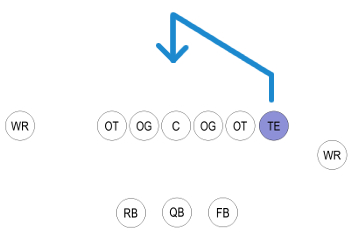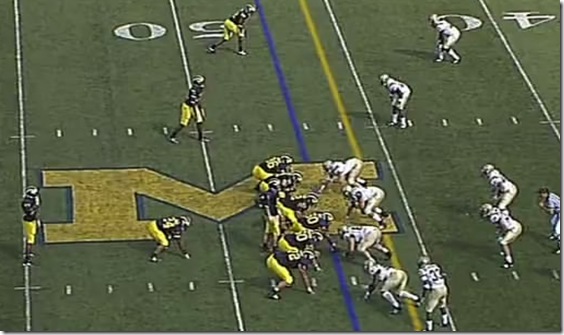Upon Further Review: The FAQ

Basics for people who don't know what the hell I'm talking about, buddy, when I do UFRs. Endeavoring to have this heavily linked in them for future usefulness.
What's a "technique"? What's a one-tech, three-tech? What the hell are you talking about, buddy?
"Techniques" refer to where defensive linemen line up relative to the offensive line. As with all good indexing systems, it starts with zero, which is head-up over the center, and increases the farther you get away from the center. Helpful diagram:
 In Michigan's current 4-3 under there are 1 and 3 technique defensive tackles on opposite sides of the center, and then Michigan aligns its DEs differently based on the formation of the opponent.
In Michigan's current 4-3 under there are 1 and 3 technique defensive tackles on opposite sides of the center, and then Michigan aligns its DEs differently based on the formation of the opponent.
Basically: 1-tech = 4-3 nose tackle, 3-tech = 4-3 defensive tackle, 0-tech = 3-4 style 350 pound space eater nose tackle.
What's the difference between strongside, weakside, playside, and backside?
Strongside and weakside are pretty self-explanatory: if there's a tight end (or two) in the game or an offset H-back/fullback, the side with more players on it is the strongside and the other side is the weakside.
Here, the strongside is to the top of the screen as that's where Kevin Koger is aligned. Some formations don't have a strong or weak side.
Playside is basically the direction the play is run in, and is important on stretch plays mostly. If the offense is running to the right, the right is the playside and the left is the backside. These terms usually get mentioned in the following ways:
- The "backside" defensive end is the player who doesn't get blocked by the defense and is instead read by the quarterback.
- I'll often refer to a good block by an interior lineman, usually the center, as sealing a guy "lined up playside of him". What this means is that the defender lined up outside of the OL—closer to the area where the running back will attempt to cut the ball up—and still sealed him away.
- Other blocks will be described as an OL "getting playside" or failing to do the same, which basically means the OL gets between the DL and his attempt to flow down the line of scrimmage and tackle as the back cuts up.
What is cover one, two, three, zero?
Cover X describes how many players are playing in a deep zone. Here's a look at a conservative cover three out of the 3-3-5 stack:
And here's a cover two out of a 4-3:
Higher X means a more conservative pass defense and more holes open underneath as more defenders are dedicated to the deep area of the field. Note that cover two usually has two deep safeties on the hashes and cover 1 or 3 usually makes do with one, using the other safety in a shorter zone or as a run defender or blitzer.
There's also a variation of cover three called "quarter-quarter-halves" where there are three deep defenders but one is tasked with half the field and the other two split the other half. This is usually a response to formations with lots of receivers on one side of the field.
What's this route you named?
- Flare: running back originally lined up in the backfield runs mostly parallel to the LOS and receives a pass behind said LOS.
- Flat: usually a slot receiver or TE but can also be a fullback or RB. Basically a really short out route that attempts to exploit cover three, which usually doesn't have defenders out there. Example.
- Out: player runs some distance downfield and then takes a hard 90 degree cut to the sideline.
- In: player runs some distance downfield and takes a hard 90 degree cut to the middle of the field.
- Drag: TE or slot receiver drags across the field maybe a yard to three downfield. Usually a checkdown that comes open late if it does at all.
- Slant: Outside WR runs diagonally up the field into an area that should be good against either man or zone coverage. Usually a short route good for 6-8 yards.
- Fly: also "go": receiver runs as fast as he can straight down the field.
- Seam: basically a fly route run by an interior receiver. Called a seam because usually there are deep middle safeties and the quarterback has to find the seam in the zone between the linebackers and said safeties.
- Post: variant of fly where after 10-20 yards, depending on the coverage, the receiver breaks his go route to the inside at a 30-45 degree angle.
- Corner: A post that breaks to the outside, usually run by slots or tight ends.
- Circle: route with an inside feint on which the receiver comes to a stop and then breaks to an out. This usually results in something of a circular path. Michigan won the Notre Dame game with one. Example.
- Wheel. Running back hauls ass out of the backfield, running what looks at first like a flare route before turning it up as he nears the sideline to attack areas a wide receiver has already dragged through to clear out a zone. Example.
- Bubble screen. Slot receiver runs parallel to the line of scrimmage in an effort to get behind the block of the outside receiver and spring downfield for 6-10 yards.
Comment or email for expansions.
September 29th, 2009 at 12:05 PM ^
September 29th, 2009 at 12:06 PM ^
September 29th, 2009 at 12:23 PM ^
September 29th, 2009 at 12:31 PM ^
September 29th, 2009 at 12:08 PM ^
September 29th, 2009 at 12:10 PM ^
September 29th, 2009 at 12:13 PM ^
September 29th, 2009 at 12:15 PM ^
September 29th, 2009 at 12:18 PM ^
September 29th, 2009 at 12:25 PM ^
September 29th, 2009 at 12:31 PM ^
September 29th, 2009 at 12:44 PM ^
September 29th, 2009 at 12:20 PM ^
September 29th, 2009 at 12:22 PM ^
September 29th, 2009 at 12:23 PM ^
September 29th, 2009 at 12:24 PM ^
September 29th, 2009 at 12:24 PM ^
September 29th, 2009 at 12:29 PM ^
September 29th, 2009 at 1:01 PM ^
September 30th, 2009 at 11:10 AM ^
September 29th, 2009 at 12:26 PM ^
September 29th, 2009 at 12:41 PM ^
September 29th, 2009 at 12:43 PM ^
September 29th, 2009 at 12:34 PM ^
 I'm guessing that's a "curl" as shown in the Cover 3 image? So then this route:
I'm guessing that's a "curl" as shown in the Cover 3 image? So then this route:
 is a "hook"?
is a "hook"?
September 29th, 2009 at 12:45 PM ^
September 29th, 2009 at 3:00 PM ^
September 30th, 2009 at 10:59 AM ^
September 30th, 2009 at 3:39 PM ^
September 29th, 2009 at 12:35 PM ^
September 29th, 2009 at 12:47 PM ^
September 29th, 2009 at 12:37 PM ^
September 29th, 2009 at 12:38 PM ^
September 29th, 2009 at 1:02 PM ^
September 29th, 2009 at 12:43 PM ^
September 29th, 2009 at 12:49 PM ^
September 29th, 2009 at 12:53 PM ^
September 29th, 2009 at 1:08 PM ^
September 29th, 2009 at 1:32 PM ^
September 29th, 2009 at 1:09 PM ^
September 29th, 2009 at 1:12 PM ^
September 29th, 2009 at 1:03 PM ^
September 29th, 2009 at 1:08 PM ^
September 29th, 2009 at 1:12 PM ^
September 29th, 2009 at 1:23 PM ^
September 29th, 2009 at 1:35 PM ^
September 29th, 2009 at 1:10 PM ^
September 29th, 2009 at 1:12 PM ^
September 29th, 2009 at 1:16 PM ^
September 29th, 2009 at 1:18 PM ^



Comments